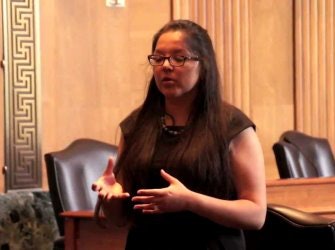 Ahniwake Rose, executive director of the National Indian Education Association (NIEA), said that “we also must acknowledge the large number of applications that are going unfunded.”
Ahniwake Rose, executive director of the National Indian Education Association (NIEA), said that “we also must acknowledge the large number of applications that are going unfunded.”The Department of the Interior and the Department of Education announced that $5.3 million in grants will go to Native American tribal organizations to help improve college readiness among tribal youth.
In a call with the press on Thursday, Education Secretary Arne Duncan said that the state of Native American education is in “crisis.” He cited high dropout rates and low college completion as major reasons for concern, although he ameliorated that assessment by noting that Native American high school graduation rates increased more than any other demographic group in 2014.
Last year’s improvement aside, Native American high school graduation rates have long been a source of concern for policy makers. In 2011-12, Native American students attending public schools had a 67 percent graduation rate, while for those students attending Bureau of Indian Education (BIE) schools, the graduation rate was 53 percent.
The grant program, which is in its first year of existence and is being billed as the Native Youth Community Projects (NYCP), appears to have elicited great interest from tribal communities. Duncan said that there were more than 70 applicants to the grant program. President Barack Obama has proposed a $50 million increase to the program for FY 2016. The $5.3 million is intended to “jumpstart” NYCP, as Duncan put it.
“While NIEA is excited to be on the call in announcing the first round of grantees, we also must acknowledge the large number of applications that are going unfunded,” Ahniwake Rose, executive director of the National Indian Education Association (NIEA), said in the call. “The president’s acknowledgement of unfulfilled promises of treaty obligations to Indian education in his budget was a significant step; however, these investments, including funding the Native Youth Community Projects, must be fulfilled by Congress.”
That $50 million request has moved out of the House of Representatives and is now awaiting the Senate’s approval. An official at the Department of Education said that the House had funded the request at $20 million.
One of the program’s goals is to move more control over education to the tribes, so they can make specific changes to current policy and practice. Native American advocates and tribes have long maintained that the tribes should have greater control over tribal education.
“The Native Youth Community Projects will work to further our commitment to tribal self-determination and self-governance by ensuring that the solutions to today’s challenges within tribal communities are formed by those who know their children best, and that’s obviously the tribes,” Duncan said.
One grant recipient is the Cook Inlet Tribal Council (CITC), a nonprofit organization dedicated to working with the many Native communities in the Cook Inlet region of Alaska. Gloria O’Neill, CITC president and CEO, said that CITC is and has been invested in improving the Anchorage school system for years now but that the new grant money would help them fund a new set of programs. CITC was specifically interested in working with middle schoolers and planned to expand its academic tutoring program; add an afterschool science program via MIT’s fab labs; and bring in elders to meet with middle schoolers, to help them connect with their heritage.
“We really see this grant as a great investment for preparing our middle schoolers for our classes in high school and ensuring that they’re ready and successful when they enter into high school,” O’Neill said.
Staff writer Catherine Morris can be reached at [email protected].





















